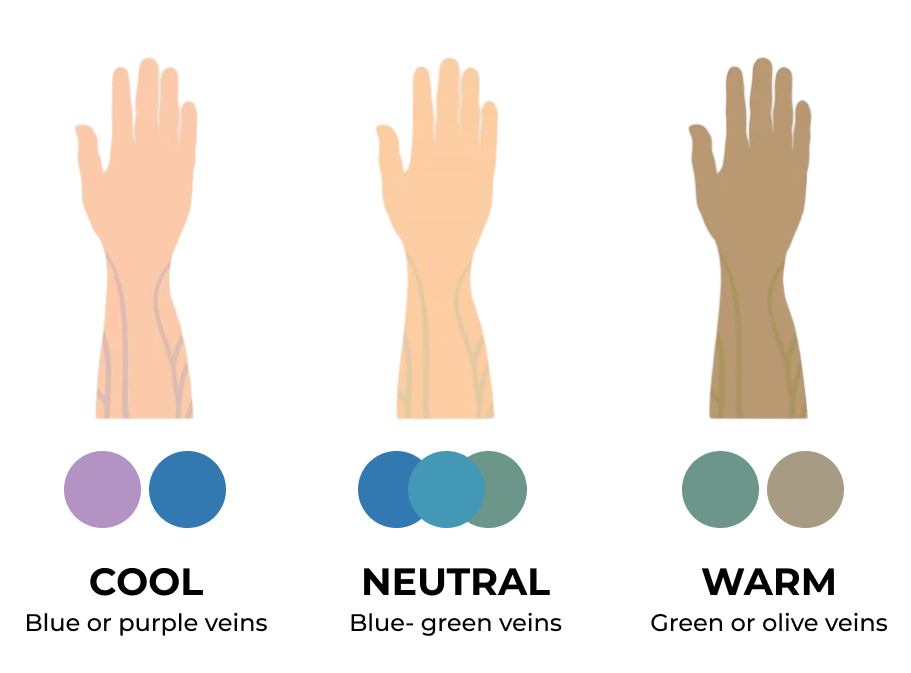
The Complete Guide to Finding Your Season
Finding the colors that make you look and feel your best is all about identifying your seasonal color palette. Using color analysis, you can discover a unique set of shades that complements your skin tone, eye color, and natural hair color.
This guide will walk you through three key steps: identifying your undertone, determining your brightness and depth, and finally, finding your sub-season.
Table of Contents
- Step 1: Find Your Undertone
- Step 2: Determine Your Brightness and Depth
- Step 3: Determine Your Sub-Season
Step 1: Find Your Undertone
Your undertone is the color that subtly influences the overall tone of your skin, even beneath the surface. There are three main types of undertones: Cool, Neutral, and Warm.

- Cool Undertone: Cool-toned individuals have a pink, red, or bluish hue beneath their skin. Silver jewelry tends to look more flattering than gold. If veins on your wrist appear blue, or you have a tendency to burn rather than tan, you may have a cool undertone.
- Neutral Undertone: Those with neutral undertones have a mix of cool and warm hues. Both silver and gold jewelry suit them, and they may find that their veins appear neither distinctly blue nor green.
- Warm Undertone: Warm-toned skin has yellow, golden, or peach undertones. Gold jewelry usually complements it better than silver. Veins on the wrist may appear greenish, and warm undertones often tan more easily.
If you're still uncertain about your undertone, trying a digital draping tool can help you visualize which colors naturally suit you. Vivaldi Color Lab offers a free color analysis quiz that guides you through this process, showing you how different colors interact with your skin tone.
Digital draping is a powerful tool for honing in on your unique undertone, as it gives you an instant visual sense of how cool, warm, or neutral tones affect your overall look. This can be especially helpful if you’re still on the fence about your undertone and want to feel more confident in your color choices.
Once you've identified your undertone, you can narrow down your color season.
Step 2: Determine Your Brightness and Depth
Brightness and depth refer to the intensity and richness of your natural coloring. These elements encompass your hair color, eye color, and skin tone.
- Brightness: If you have vivid, bright eye coloring or high contrast between your hair and skin, you may fall into a bright season. People with brighter coloring can often wear bolder colors and benefit from clear hues that reflect the brightness of their physical features.
- Depth: If your natural coloring is deeper, with rich eye color and dark or very dark hair, you are likely in a season with greater depth. Deeper seasons suit darker, richer tones that bring out the contrast in their coloring without overwhelming their features.
Step 3: Determine Your Sub-Season
Once you’ve identified your undertone and intensity, it’s time to pinpoint your sub-season. The 12 seasons include variations of the four main seasons: Spring, Summer, Autumn, and Winter. Each season has three variations based on undertone and intensity.
Spring Seasons
- Bright Spring: Vibrant and neutral warm. Best suited to clear, warm colors like cyan, kelly green, and true yellow.
- Warm Spring: A balance of warmth and brightness. Colors like grass green, orange red, and golden yellow work well.
- Light Spring: Light and warm with soft, pastel tones. Think light peach, soft turquoise, and light coral.
Summer Seasons
- Soft Summer: Soft and neutral cool. Best colors are dusty rose, lavender, and soft blues.
- Cool Summer: Cool with shades like slate blue, mauve, and powder pink.
- Light Summer: Light and cool with shades such as light periwinkle, soft lilac, and powdery pinks.
Autumn Seasons
- Deep Autumn: Dark and neutral warm with earthy tones like burgundy, forest green, and burnt orange.
- Warm Autumn: A balance of warmth and depth. Best colors are rich browns, gold, and olive green.
- Soft Autumn: Soft, neutral warm shades like sage, taupe, and warm beige.
Winter Seasons
- Cool Winter: Cool, deep, and bold. Best colors include royal blue, magenta, and emerald.
- Bright Winter: High contrast and cool. Colors like black, pure white, and clear red are ideal.
- Deep Winter: Deep and neutral cool with shades such as charcoal, deep plum, and navy.
If you’re still uncertain about analyzing your season on your own, Vivaldi Color Lab has an AI analysis feature that can take the guesswork out of the process. By simply uploading a photo, the AI will automatically detect your season and provide you with a personalized color palette tailored to your specific undertone, brightness, and depth.
Alongside your best colors, you'll also receive guidance on which colors to avoid, making it easier than ever to curate a wardrobe that flatters you from every angle. This tool can be a game-changer if you want a reliable, accurate analysis with the ease of a single upload.
By identifying your undertone, intensity, and sub-season, you can unlock a color palette that enhances your natural beauty. Embracing your unique color season is a great way to refine your wardrobe and makeup choices, ensuring every color complements your individual look.
Related Reading
- Deep Autumn vs Deep Winter: A Deep-Dive Comparison
- Light Spring vs Light Summer: What's the Difference?
- 5 Best Color Analysis Apps for Finding Your Season
- Are You Low, Medium, or High Contrast?
- Best Neutrals for Every Color Season: Complete Guide
- Why Digital Draping?
- DIY Color Analysis: Discovering Your Season From Home
